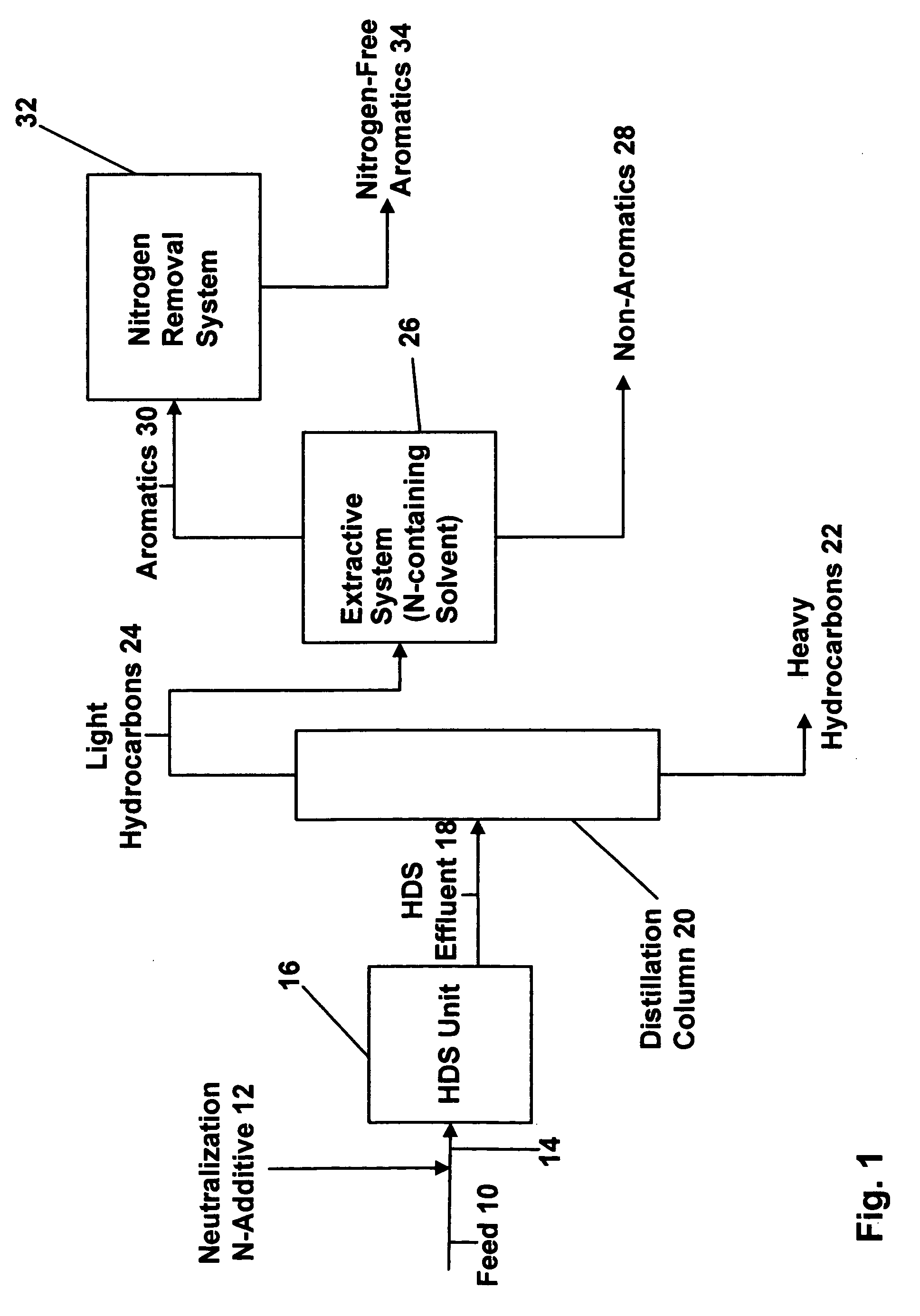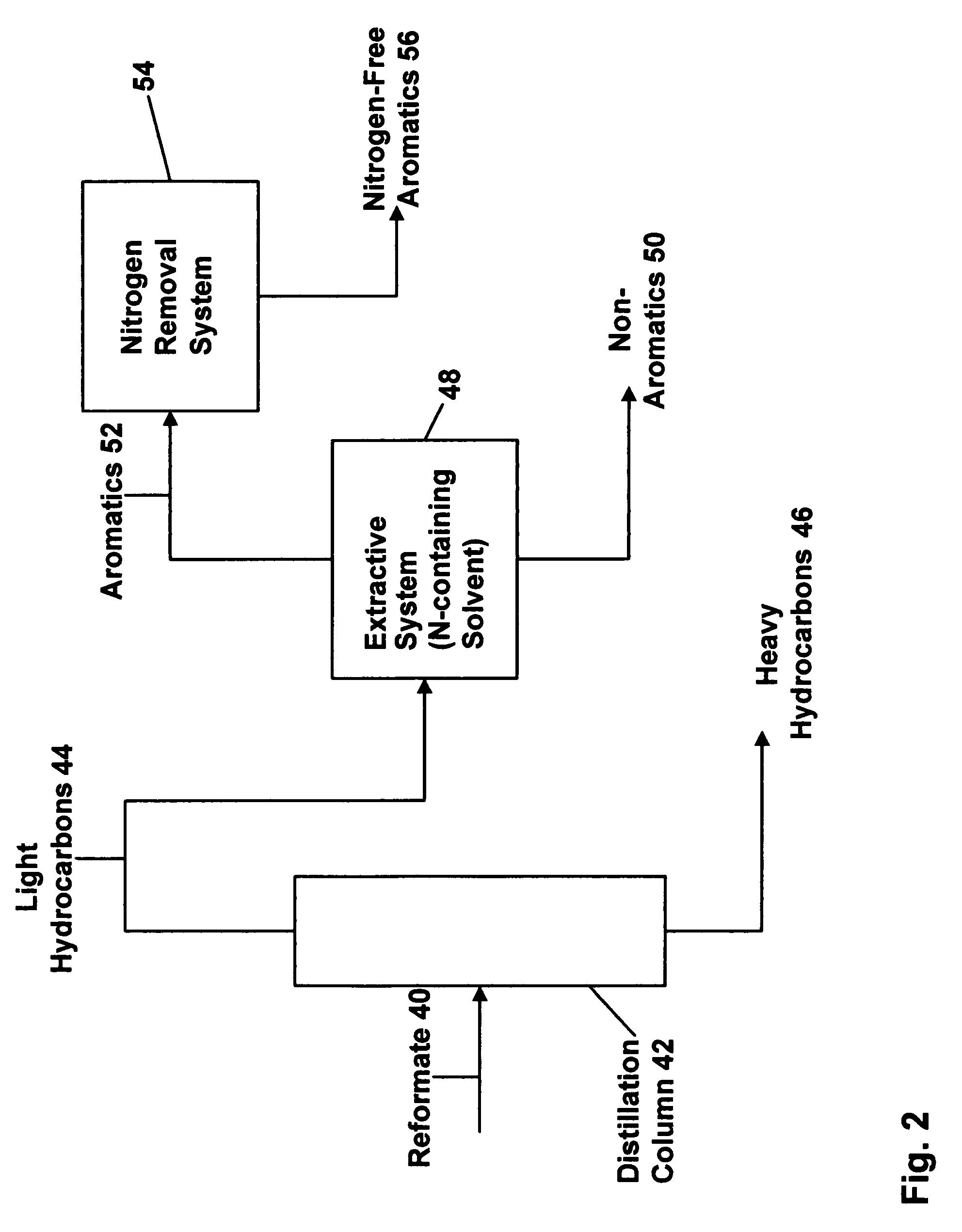Process for producing petroleum oils with ultra-low nitrogen content
a petroleum oil and nitrogen content technology, applied in the direction of hydrocarbon distillation, hydrocarbon oil treatment products, separation processes, etc., can solve the problems of high cost of adsorbent regeneration, low efficiency of subsequent catalytic processes, and inability to commercialize methods, etc., to achieve high petroleum oil recovery, enhance extraction, and high efficiency
- Summary
- Abstract
- Description
- Claims
- Application Information
AI Technical Summary
Benefits of technology
Problems solved by technology
Method used
Image
Examples
example 1
[0051] In this example, an aromatic hydrocarbon composition that is representative of the HDS effluent 18 that would be fed into the distillation column 20 of FIG. 1 was prepared. The composition includes a small amount of high molecular weight nitrogen compounds of the kind used as the neutralization additives that are added to the feedstock 10 before being that is charged into the HDS unit 16. The composition which consisted of almost 98 wt % aromatics included the following components as set forth in Table 1.
TABLE 1Componentweight %C6 paraffins0.67C7 paraffins0.14cyclopentane0.49cyclohexane0.64benzene83.96toluene13.93nitrogen compounds(0.3 ppm)
[0052] Approximately 100 grams of this composition were contacted with 100 grams of deionized water in a separatory funnel at ambient temperature. The funnel was shaken vigorously to allow the immiscible components to be well mixed; once the shaking stopped, the aromatics and water separated from each other instantaneously so as to establ...
example 2
[0053] Using the same extraction procedure described in Example 1, a benzene composition containing about 97.5 wt % benzene, 2.5 wt % of C6 to C7 non-aromatics, and trace amounts (2.9 ppm) of nitrogen compounds was extracted three times with fresh de-ionized water. The water-to-benzene composition weight ratio for each extraction was 1:1. The hydrocarbon (benzene) phase was analyzed for trace nitrogen after each extraction stage and the results are given in Table 2.
TABLE 2ExtractionNitrogen in BenzeneNitrogenStagePhase (ppm)Removal (%)02.90.010.36387.520.08897.030.07897.3
[0054] As is apparent, the nitrogen content in the benzene phase was reduced from 2.9 ppm to 0.078 ppm (or 78 ppb) which is a 97.3% reduction. This demonstrates that water is an excellent extractive solvent to remove nitrogen compounds from benzene.
example 3
[0055] The nitrogen extraction procedure of Example 2 was repeated but with less water, i.e., at lower water-to-benzene composition ratios of 0.5 and 0.1. The hydrocarbon (benzene) phase was analyzed for nitrogen after each extraction stage and the results are given in Table 3.
TABLE 3ExtractionNitrogen in BenzeneNitrogenStagePhase (ppm)Removal (%)Experiment 1 Water-To-Benzene Weight Ratio: 0.502.90.010.43285.120.18393.7Experiment 2 Water-To-Benzene Weight Ratio: 0.102.90.011.3453.820.57780.130.37587.140.28990.050.23192.0
[0056] This experiment demonstrated that more nitrogen compounds are extracted from the benzene phase when more extractive solvent, i.e., water, is used at any particular stage. Moreover, for each water-to-benzene weight ratio, successive extraction will further reduce the amount of nitrogen in the benzene phase.
PUM
 Login to View More
Login to View More Abstract
Description
Claims
Application Information
 Login to View More
Login to View More - R&D
- Intellectual Property
- Life Sciences
- Materials
- Tech Scout
- Unparalleled Data Quality
- Higher Quality Content
- 60% Fewer Hallucinations
Browse by: Latest US Patents, China's latest patents, Technical Efficacy Thesaurus, Application Domain, Technology Topic, Popular Technical Reports.
© 2025 PatSnap. All rights reserved.Legal|Privacy policy|Modern Slavery Act Transparency Statement|Sitemap|About US| Contact US: help@patsnap.com



